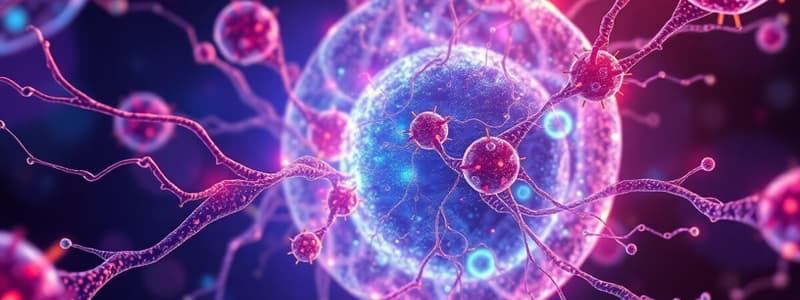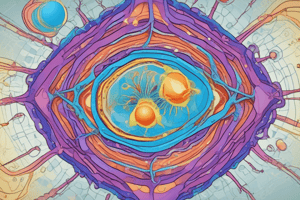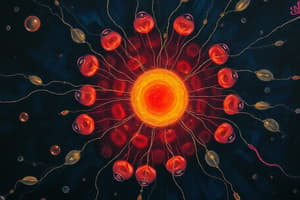Podcast
Questions and Answers
What is the primary role of the cytoskeleton in a cell?
What is the primary role of the cytoskeleton in a cell?
Which of the following describes vaults in cellular terms?
Which of the following describes vaults in cellular terms?
What is the main function of the phospholipid bilayer in the plasma membrane?
What is the main function of the phospholipid bilayer in the plasma membrane?
How do lipids function in cellular membranes?
How do lipids function in cellular membranes?
Signup and view all the answers
What cellular process is described by endocytosis?
What cellular process is described by endocytosis?
Signup and view all the answers
What is the primary role of carbohydrates in cellular function?
What is the primary role of carbohydrates in cellular function?
Signup and view all the answers
Which of the following best describes membrane potential?
Which of the following best describes membrane potential?
Signup and view all the answers
What is the main function of cell receptors on the plasma membrane?
What is the main function of cell receptors on the plasma membrane?
Signup and view all the answers
What is the main purpose of mitosis in living organisms?
What is the main purpose of mitosis in living organisms?
Signup and view all the answers
During which phase of the cell cycle does DNA replication occur?
During which phase of the cell cycle does DNA replication occur?
Signup and view all the answers
Which factor is NOT mentioned as influencing the cell cycle?
Which factor is NOT mentioned as influencing the cell cycle?
Signup and view all the answers
What is the role of cytokinesis in the cell division process?
What is the role of cytokinesis in the cell division process?
Signup and view all the answers
How do cells communicate to stop growing when healing is complete?
How do cells communicate to stop growing when healing is complete?
Signup and view all the answers
What is the primary function of lysosomes within a cell?
What is the primary function of lysosomes within a cell?
Signup and view all the answers
Which organelle is responsible for the synthesis of proteins?
Which organelle is responsible for the synthesis of proteins?
Signup and view all the answers
Which organelle is known as the powerhouse of the cell?
Which organelle is known as the powerhouse of the cell?
Signup and view all the answers
What role do the endoplasmic reticulum play in the cell?
What role do the endoplasmic reticulum play in the cell?
Signup and view all the answers
What is a key feature of the nucleus?
What is a key feature of the nucleus?
Signup and view all the answers
Which of the following organelles originates from the Golgi complex?
Which of the following organelles originates from the Golgi complex?
Signup and view all the answers
What is the main function of the Golgi complex?
What is the main function of the Golgi complex?
Signup and view all the answers
What do peroxisomes primarily participate in?
What do peroxisomes primarily participate in?
Signup and view all the answers
Which cellular structure prevents the cell from shrinking?
Which cellular structure prevents the cell from shrinking?
Signup and view all the answers
What do ribosomes consist of?
What do ribosomes consist of?
Signup and view all the answers
What is the primary purpose of endocytosis in cells?
What is the primary purpose of endocytosis in cells?
Signup and view all the answers
Which phase of the cell cycle is primarily involved in DNA replication?
Which phase of the cell cycle is primarily involved in DNA replication?
Signup and view all the answers
What does depolarization of a cell typically indicate during an action potential?
What does depolarization of a cell typically indicate during an action potential?
Signup and view all the answers
Which of the following processes is NOT associated with exocytosis?
Which of the following processes is NOT associated with exocytosis?
Signup and view all the answers
What is the primary function of the sodium-potassium pump?
What is the primary function of the sodium-potassium pump?
Signup and view all the answers
Which of the following describes the relationship between mitosis and cytokinesis?
Which of the following describes the relationship between mitosis and cytokinesis?
Signup and view all the answers
What happens during the repolarization phase of an action potential?
What happens during the repolarization phase of an action potential?
Signup and view all the answers
What role do vesicles play in cellular transport?
What role do vesicles play in cellular transport?
Signup and view all the answers
During which phase do cells grow and prepare for division?
During which phase do cells grow and prepare for division?
Signup and view all the answers
What is the consequence of losing insulin production in type I diabetes?
What is the consequence of losing insulin production in type I diabetes?
Signup and view all the answers
Which condition is characterized by the destruction of protective wrappings around nerve cells?
Which condition is characterized by the destruction of protective wrappings around nerve cells?
Signup and view all the answers
In type II diabetes, what issue do the cells face regarding insulin?
In type II diabetes, what issue do the cells face regarding insulin?
Signup and view all the answers
What results from multiple signaling breakdowns in cell communication?
What results from multiple signaling breakdowns in cell communication?
Signup and view all the answers
What occurs during a stroke?
What occurs during a stroke?
Signup and view all the answers
What are common symptoms of multiple sclerosis due to nerve damage?
What are common symptoms of multiple sclerosis due to nerve damage?
Signup and view all the answers
What leads to dangerously high blood sugar levels in both types of diabetes?
What leads to dangerously high blood sugar levels in both types of diabetes?
Signup and view all the answers
How does the body normally respond to sugar in the bloodstream?
How does the body normally respond to sugar in the bloodstream?
Signup and view all the answers
What is the primary result of insulin loss in diabetes?
What is the primary result of insulin loss in diabetes?
Signup and view all the answers
What is a primary factor contributing to cancer development related to cellular communication?
What is a primary factor contributing to cancer development related to cellular communication?
Signup and view all the answers
Study Notes
Cytoskeleton
- Serves as the "bones and muscles" of the cell, providing shape and support.
- Composed of protein filaments, enabling cell extensions.
Vaults
- Cytoplasmic ribonucleoproteins with an octagonal barrel shape.
- Function as cellular transport vehicles, akin to "trucks."
Cell Membrane
- Known as the plasma membrane or phospholipid bilayer, allows selective substance passage.
- Composed of hydrophilic heads and hydrophobic tails.
Membrane Functions
- Cell-to-cell recognition helps distinguish normal from cancerous cells.
- Membrane potential created by potassium and sodium channels enables electrical energy.
- Endocytosis allows for intake of liquids and molecules; exocytosis expels waste and secretes hormones.
Organelles Overview
- Plasma membrane: outer layer of the cell.
- Cytoplasm: fluid medium that maintains cell structure.
- Organelles include nucleus, nucleolus, lysosome, mitochondria, ribosomes, endoplasmic reticulum, Golgi complex.
Nucleus
- Largest membrane-bound organelle housing DNA and nuclear envelope.
- Plays a key role in cell division and storing genetic information.
Ribosomes
- Composed of RNA-protein complexes, synthesized in the nucleolus.
- Function as sites for protein synthesis, essential for cell replication.
Endoplasmic Reticulum
- Features cisternae; is involved in synthesizing and transporting proteins and lipids.
Golgi Complex
- Responsible for processing and packaging proteins into secretory vesicles for transportation to neighboring cells.
Lysosomes
- Originate from the Golgi complex and contain digestive enzymes for cellular digestion.
- Cellular injury can release enzymes leading to autolysis (self-digestion).
Mitochondria
- Regarded as the "powerhouse of the cell," generating ATP for energy metabolism.
- Involved in osmotic regulation, pH control, calcium homeostasis, and cell signaling.
Peroxisomes
- Involved in oxidation processes, containing enzymes that convert cellular waste to harmless products.
Cellular Communication Issues
- Loss of signal: In type I diabetes, lack of insulin production leads to high blood sugar levels.
- Target failure: In multiple sclerosis, nerve signal transmission is hindered, causing various neurological issues.
- Target insensitivity: Type II diabetes involves cells becoming unresponsive to insulin despite its presence.
- Breakdowns: Uncontrolled cell growth leading to cancer often stems from multiple communication failures.
- Excess signaling: In strokes, blocked blood flow leads to cell death in the affected brain regions.
Transport Mechanisms
- Endocytosis: Forming vesicles to take in fluids (pinocytosis) or particles (phagocytosis).
- Exocytosis: Vesicles fuse with plasma membrane to release substances, replacing plasma membrane components.
Membrane Potential
- Resting membrane potential enables electrical energy generation; critical for actions like heart muscle contractions.
- Action potential involves depolarization followed by repolarization, with a refractory period ensuring proper cycle.
The Cell Cycle
- An ordered sequence of events involving cell growth and replication, resulting in two daughter cells.
- Composed of interphase (growth and DNA replication) and mitotic phase (separation and division of DNA and cytoplasm).
Phases of the Cell Cycle
- G1 phase: Cell grows and prepares for division.
- S phase: DNA is replicated.
- G2 phase: Cell checks for correct DNA replication.
- M phase: PMitosis occurs; cell divides into two.
Growth Regulation
- Cells communicate chemical signals to regulate growth, ensuring appropriate division during healing and normal development.
Factors Influencing the Cell Cycle
- Protein growth factors, genetic mutations, and epigenetic factors can affect cellular division rates.
Tissue Formation
- Involves intercellular communication, adhesion, and memory, leading to specialized gene expressions and cellular differentiation.
- Cells aggregate into tissues, form organs, and organize into organ systems, foundational to biological functioning.
Studying That Suits You
Use AI to generate personalized quizzes and flashcards to suit your learning preferences.
Description
Test your knowledge on cell organelles, focusing on the cytoskeleton and vaults. Understand the structure and function of these essential cellular components, including their roles in maintaining cell shape and transport. Perfect for students in biological sciences!




